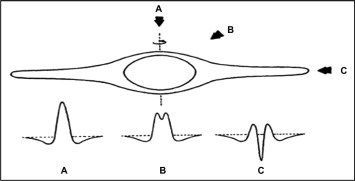
Figure above proposed a Be star model envelope, showing how the observed line profiles depended on viewing angle. The three position are, Pole on (a), with inclination angle on line of sight (b) and equator on (c).
For the Be stars that possess shell spectra of the absorption type, most of them would lie in velocity range of 150–200 km s−1. The probable mechanism of emission ring formation has been described by Struve as follows: “It is tempting to suggest that the rapidly rotating B stars are unstable at their equators and that they are losing mass through rotational breakup. In 1950 Merrill turn the attention to a subclass of Be stars known as shell stars. Term shell stars has special meaning when applied to B-type stars, they are stars with spectra showing emission wings in one or more of hydrogen lines, sharp hydrogen absorption cores plus narrow absorption lines of ionized metals, and weak diffuse absorption lines of neutral helium.
Bright examples of shell stars defined in this way include γ Cas, φ Per, ψ Per Pleione (28 Tauri), ζ Tau and 48 Lib. It should be emphasized that shell stars just represent one phase of the Be phenomenon, so shell stars are nothing else than Be stars viewed under specific inclination angle.
The shell phenomenon is produced most probably by equatorial gaseous disks or rings whose planes are oriented approximately close to the line of sight as shown left. While all B-type shell stars are Be stars, not all Be stars show shell spectra as defined above. Some Be stars never show shell spectra (because of the inclination of the rotation axis), while the shell spectrum comes and goes in others like Pleione.